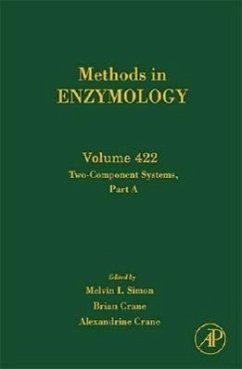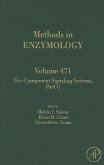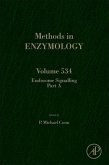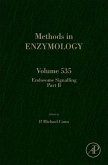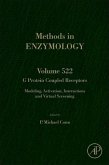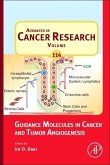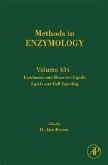Melvin I. Simon (Volume ed.) / Brian Crane / Alexandrine CraneVolume 422
Two-Component Signaling Systems, Part a
Volume 422
Herausgegeben:Simon, Melvin I.; Crane, Brian; Crane, Alexandrine
Melvin I. Simon (Volume ed.) / Brian Crane / Alexandrine CraneVolume 422
Two-Component Signaling Systems, Part a
Volume 422
Herausgegeben:Simon, Melvin I.; Crane, Brian; Crane, Alexandrine
- Gebundenes Buch
- Merkliste
- Auf die Merkliste
- Bewerten Bewerten
- Teilen
- Produkt teilen
- Produkterinnerung
- Produkterinnerung
Multicellular organisms must be able to adapt to cellular events to accommodate prevailing conditions. Sensory-response circuits operate by making use of a phosphorylation control mechanism known as the "two-component system." Sections include: Computational Analyses of Sequences and Sequence Alignments Biochemical and Genetic Assays of Individual Components of Signaling Systems Physiological Assays and Readouts
Andere Kunden interessierten sich auch für
![Two-Component Signaling Systems, Part C Two-Component Signaling Systems, Part C]() Two-Component Signaling Systems, Part C142,99 €
Two-Component Signaling Systems, Part C142,99 €![Endosome Signaling Part a Endosome Signaling Part a]() Endosome Signaling Part a133,99 €
Endosome Signaling Part a133,99 €![Endosome Signaling Part B Endosome Signaling Part B]() Endosome Signaling Part B133,99 €
Endosome Signaling Part B133,99 €![G Protein Coupled Receptors G Protein Coupled Receptors]() G Protein Coupled Receptors133,99 €
G Protein Coupled Receptors133,99 €![Guidance Molecules in Cancer and Tumor Angiogenesis Guidance Molecules in Cancer and Tumor Angiogenesis]() Guidance Molecules in Cancer and Tumor Angiogenesis111,99 €
Guidance Molecules in Cancer and Tumor Angiogenesis111,99 €![Mechanisms of Regeneration Mechanisms of Regeneration]() Mechanisms of Regeneration137,99 €
Mechanisms of Regeneration137,99 €![Lipidomics and Bioactive Lipids: Lipids and Cell Signaling Lipidomics and Bioactive Lipids: Lipids and Cell Signaling]() H. Alex Brown (Volume ed.)Lipidomics and Bioactive Lipids: Lipids and Cell Signaling146,99 €
H. Alex Brown (Volume ed.)Lipidomics and Bioactive Lipids: Lipids and Cell Signaling146,99 €-
-
-
Multicellular organisms must be able to adapt to cellular events to accommodate prevailing conditions. Sensory-response circuits operate by making use of a phosphorylation control mechanism known as the "two-component system." Sections include: Computational Analyses of Sequences and Sequence Alignments Biochemical and Genetic Assays of Individual Components of Signaling Systems Physiological Assays and Readouts
Produktdetails
- Produktdetails
- Methods in Enzymology Volume 422
- Verlag: Academic Press / Elsevier Science & Technology
- Artikelnr. des Verlages: S0076-6879(06)X2200-0
- Seitenzahl: 592
- Erscheinungstermin: 3. Juli 2007
- Englisch
- Abmessung: 229mm x 162mm x 41mm
- Gewicht: 1250g
- ISBN-13: 9780123738516
- ISBN-10: 0123738512
- Artikelnr.: 22881872
- Herstellerkennzeichnung
- Libri GmbH
- Europaallee 1
- 36244 Bad Hersfeld
- 06621 890
- Methods in Enzymology Volume 422
- Verlag: Academic Press / Elsevier Science & Technology
- Artikelnr. des Verlages: S0076-6879(06)X2200-0
- Seitenzahl: 592
- Erscheinungstermin: 3. Juli 2007
- Englisch
- Abmessung: 229mm x 162mm x 41mm
- Gewicht: 1250g
- ISBN-13: 9780123738516
- ISBN-10: 0123738512
- Artikelnr.: 22881872
- Herstellerkennzeichnung
- Libri GmbH
- Europaallee 1
- 36244 Bad Hersfeld
- 06621 890
Section I. Computational Analyses of Sequences and Sequence Alignments
CHAPTER 1: Comparative genomic and protein sequence analyses of a complex system controlling bacterial chemotaxis.
CHAPTER 2: Two component systems in microbial communities: Approaches and resources for analyzing metagenomic data sets.
CHAPTER 3: Identification of sensory and signal-transducing domains in two-component signaling systems.
CHAPTER 4: Features of protein-protein interactions in two-component signaling deduced from genomic libraries.
CHAPTER 5: Sporulation phosphorelay proteins and their complexes: Crystallographic characterization.
CHAPTER 6: Control Analysis of Bacterial Chemotaxis Signaling.
CHAPTER 7: Classification of Response Regulators based on their Surface Properties
Section II. Biochemical and Genetic Assays of Individual Components of the Signaling Systems
CHAPTER 8: Purification and Assays of Rhodobacter capsulatus RegB-RegA Two Component Signal Transduction System.
CHAPTER 9: Purification and reconstitution of PYP-phytochrome (Ppr) with biliverdin and 4-hydroxycinnamic acid.
CHAPTER 10: Oxygen and Redox-Sensing by Two-Component Systems That Regulate Behavioral Responses. Behavioral Assays and Structural Studies of Aer using in vivo Disulfide Crosslinking.
CHAPTER 11: Two-Component Signaling in the Virulence of S. aureus: A Silkworm Larvae-Pathogenic Agent Infection Model of Virulence.
CHAPTER 12: TonB System, In vivo Assays and Characterization
CHAPTER 13: Biochemical Characterization of Plant Ethylene Receptors following Transgenic Expression in Yeast.
CHAPTER 14: Structure of SixA, a histidine protein phosphatase of the ArcB HPt domain in E. coli.
CHAPTER 15: Triggering and monitoring light-sensing reactions in protein crystals
CHAPTER 16
CHAPTER 17: Application of Fluorescence Resonance Energy Transfer to Examine EnvZ/OmpR Interactions
CHAPTER 18: Gene promoter scan (GPS) methodology for identifying and classifying co-regulated promoters.
CHAPTER 19: Targeting two-component signal transduction: A novel drug discovery system.
CHAPTER 20: The essential YycFG two-component system of Bacillus subtilis
Section III. Physiological Assays and Readouts
CHAPTER 21: Isolation and Characterization of Chemotaxis Mutants of the Lyme Disease Spirochete Borrelia burgdorferi Using Allelic Exchange Mutagenesis, Flow Cytometry and Cell Tracking.
CHAPTER 22: Phosphorylation assays of chemotaxis two-component system proteins in Borrelia burgdorferi.
CHAPTER 23: Regulation of Respiratory Genes by ResD-ResE Signal Transduction System in Bacillus subtilis.
CHAPTER 24: Physiological and genetic characterization of two-component systems in Myxococcus.
CHAPTER 25: Detection and measurement of two-component systems that control dimorphism and virulence in fungi.
CHAPTER 26: Using Two-Component Systems and other Bacterial Regulatory Factors for the Fabrication of Synthetic Genetic Devices.
CHAPTER 1: Comparative genomic and protein sequence analyses of a complex system controlling bacterial chemotaxis.
CHAPTER 2: Two component systems in microbial communities: Approaches and resources for analyzing metagenomic data sets.
CHAPTER 3: Identification of sensory and signal-transducing domains in two-component signaling systems.
CHAPTER 4: Features of protein-protein interactions in two-component signaling deduced from genomic libraries.
CHAPTER 5: Sporulation phosphorelay proteins and their complexes: Crystallographic characterization.
CHAPTER 6: Control Analysis of Bacterial Chemotaxis Signaling.
CHAPTER 7: Classification of Response Regulators based on their Surface Properties
Section II. Biochemical and Genetic Assays of Individual Components of the Signaling Systems
CHAPTER 8: Purification and Assays of Rhodobacter capsulatus RegB-RegA Two Component Signal Transduction System.
CHAPTER 9: Purification and reconstitution of PYP-phytochrome (Ppr) with biliverdin and 4-hydroxycinnamic acid.
CHAPTER 10: Oxygen and Redox-Sensing by Two-Component Systems That Regulate Behavioral Responses. Behavioral Assays and Structural Studies of Aer using in vivo Disulfide Crosslinking.
CHAPTER 11: Two-Component Signaling in the Virulence of S. aureus: A Silkworm Larvae-Pathogenic Agent Infection Model of Virulence.
CHAPTER 12: TonB System, In vivo Assays and Characterization
CHAPTER 13: Biochemical Characterization of Plant Ethylene Receptors following Transgenic Expression in Yeast.
CHAPTER 14: Structure of SixA, a histidine protein phosphatase of the ArcB HPt domain in E. coli.
CHAPTER 15: Triggering and monitoring light-sensing reactions in protein crystals
CHAPTER 16
CHAPTER 17: Application of Fluorescence Resonance Energy Transfer to Examine EnvZ/OmpR Interactions
CHAPTER 18: Gene promoter scan (GPS) methodology for identifying and classifying co-regulated promoters.
CHAPTER 19: Targeting two-component signal transduction: A novel drug discovery system.
CHAPTER 20: The essential YycFG two-component system of Bacillus subtilis
Section III. Physiological Assays and Readouts
CHAPTER 21: Isolation and Characterization of Chemotaxis Mutants of the Lyme Disease Spirochete Borrelia burgdorferi Using Allelic Exchange Mutagenesis, Flow Cytometry and Cell Tracking.
CHAPTER 22: Phosphorylation assays of chemotaxis two-component system proteins in Borrelia burgdorferi.
CHAPTER 23: Regulation of Respiratory Genes by ResD-ResE Signal Transduction System in Bacillus subtilis.
CHAPTER 24: Physiological and genetic characterization of two-component systems in Myxococcus.
CHAPTER 25: Detection and measurement of two-component systems that control dimorphism and virulence in fungi.
CHAPTER 26: Using Two-Component Systems and other Bacterial Regulatory Factors for the Fabrication of Synthetic Genetic Devices.
Section I. Computational Analyses of Sequences and Sequence Alignments
CHAPTER 1: Comparative genomic and protein sequence analyses of a complex system controlling bacterial chemotaxis.
CHAPTER 2: Two component systems in microbial communities: Approaches and resources for analyzing metagenomic data sets.
CHAPTER 3: Identification of sensory and signal-transducing domains in two-component signaling systems.
CHAPTER 4: Features of protein-protein interactions in two-component signaling deduced from genomic libraries.
CHAPTER 5: Sporulation phosphorelay proteins and their complexes: Crystallographic characterization.
CHAPTER 6: Control Analysis of Bacterial Chemotaxis Signaling.
CHAPTER 7: Classification of Response Regulators based on their Surface Properties
Section II. Biochemical and Genetic Assays of Individual Components of the Signaling Systems
CHAPTER 8: Purification and Assays of Rhodobacter capsulatus RegB-RegA Two Component Signal Transduction System.
CHAPTER 9: Purification and reconstitution of PYP-phytochrome (Ppr) with biliverdin and 4-hydroxycinnamic acid.
CHAPTER 10: Oxygen and Redox-Sensing by Two-Component Systems That Regulate Behavioral Responses. Behavioral Assays and Structural Studies of Aer using in vivo Disulfide Crosslinking.
CHAPTER 11: Two-Component Signaling in the Virulence of S. aureus: A Silkworm Larvae-Pathogenic Agent Infection Model of Virulence.
CHAPTER 12: TonB System, In vivo Assays and Characterization
CHAPTER 13: Biochemical Characterization of Plant Ethylene Receptors following Transgenic Expression in Yeast.
CHAPTER 14: Structure of SixA, a histidine protein phosphatase of the ArcB HPt domain in E. coli.
CHAPTER 15: Triggering and monitoring light-sensing reactions in protein crystals
CHAPTER 16
CHAPTER 17: Application of Fluorescence Resonance Energy Transfer to Examine EnvZ/OmpR Interactions
CHAPTER 18: Gene promoter scan (GPS) methodology for identifying and classifying co-regulated promoters.
CHAPTER 19: Targeting two-component signal transduction: A novel drug discovery system.
CHAPTER 20: The essential YycFG two-component system of Bacillus subtilis
Section III. Physiological Assays and Readouts
CHAPTER 21: Isolation and Characterization of Chemotaxis Mutants of the Lyme Disease Spirochete Borrelia burgdorferi Using Allelic Exchange Mutagenesis, Flow Cytometry and Cell Tracking.
CHAPTER 22: Phosphorylation assays of chemotaxis two-component system proteins in Borrelia burgdorferi.
CHAPTER 23: Regulation of Respiratory Genes by ResD-ResE Signal Transduction System in Bacillus subtilis.
CHAPTER 24: Physiological and genetic characterization of two-component systems in Myxococcus.
CHAPTER 25: Detection and measurement of two-component systems that control dimorphism and virulence in fungi.
CHAPTER 26: Using Two-Component Systems and other Bacterial Regulatory Factors for the Fabrication of Synthetic Genetic Devices.
CHAPTER 1: Comparative genomic and protein sequence analyses of a complex system controlling bacterial chemotaxis.
CHAPTER 2: Two component systems in microbial communities: Approaches and resources for analyzing metagenomic data sets.
CHAPTER 3: Identification of sensory and signal-transducing domains in two-component signaling systems.
CHAPTER 4: Features of protein-protein interactions in two-component signaling deduced from genomic libraries.
CHAPTER 5: Sporulation phosphorelay proteins and their complexes: Crystallographic characterization.
CHAPTER 6: Control Analysis of Bacterial Chemotaxis Signaling.
CHAPTER 7: Classification of Response Regulators based on their Surface Properties
Section II. Biochemical and Genetic Assays of Individual Components of the Signaling Systems
CHAPTER 8: Purification and Assays of Rhodobacter capsulatus RegB-RegA Two Component Signal Transduction System.
CHAPTER 9: Purification and reconstitution of PYP-phytochrome (Ppr) with biliverdin and 4-hydroxycinnamic acid.
CHAPTER 10: Oxygen and Redox-Sensing by Two-Component Systems That Regulate Behavioral Responses. Behavioral Assays and Structural Studies of Aer using in vivo Disulfide Crosslinking.
CHAPTER 11: Two-Component Signaling in the Virulence of S. aureus: A Silkworm Larvae-Pathogenic Agent Infection Model of Virulence.
CHAPTER 12: TonB System, In vivo Assays and Characterization
CHAPTER 13: Biochemical Characterization of Plant Ethylene Receptors following Transgenic Expression in Yeast.
CHAPTER 14: Structure of SixA, a histidine protein phosphatase of the ArcB HPt domain in E. coli.
CHAPTER 15: Triggering and monitoring light-sensing reactions in protein crystals
CHAPTER 16
CHAPTER 17: Application of Fluorescence Resonance Energy Transfer to Examine EnvZ/OmpR Interactions
CHAPTER 18: Gene promoter scan (GPS) methodology for identifying and classifying co-regulated promoters.
CHAPTER 19: Targeting two-component signal transduction: A novel drug discovery system.
CHAPTER 20: The essential YycFG two-component system of Bacillus subtilis
Section III. Physiological Assays and Readouts
CHAPTER 21: Isolation and Characterization of Chemotaxis Mutants of the Lyme Disease Spirochete Borrelia burgdorferi Using Allelic Exchange Mutagenesis, Flow Cytometry and Cell Tracking.
CHAPTER 22: Phosphorylation assays of chemotaxis two-component system proteins in Borrelia burgdorferi.
CHAPTER 23: Regulation of Respiratory Genes by ResD-ResE Signal Transduction System in Bacillus subtilis.
CHAPTER 24: Physiological and genetic characterization of two-component systems in Myxococcus.
CHAPTER 25: Detection and measurement of two-component systems that control dimorphism and virulence in fungi.
CHAPTER 26: Using Two-Component Systems and other Bacterial Regulatory Factors for the Fabrication of Synthetic Genetic Devices.

